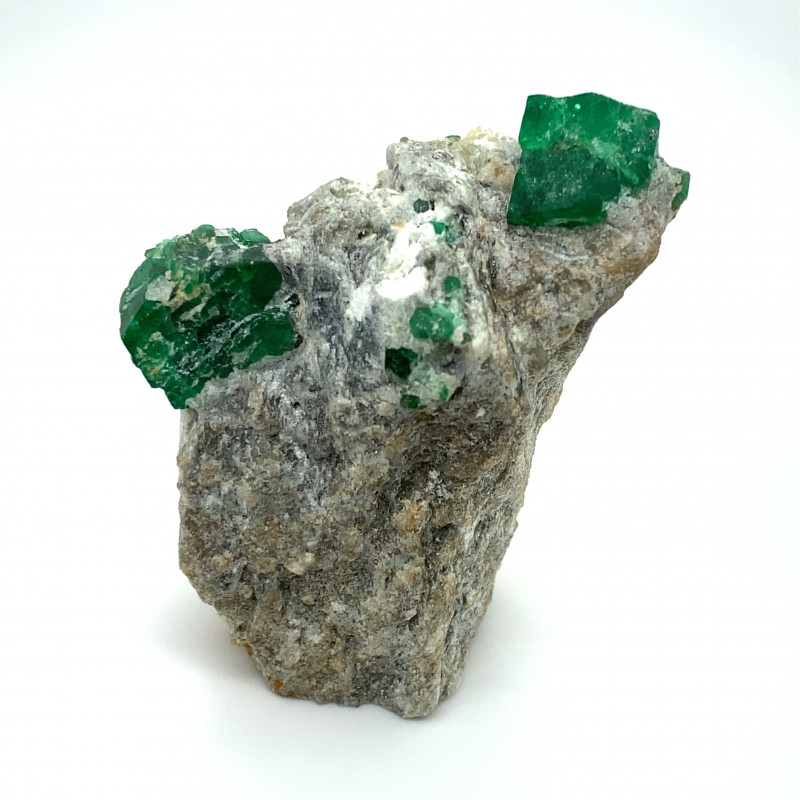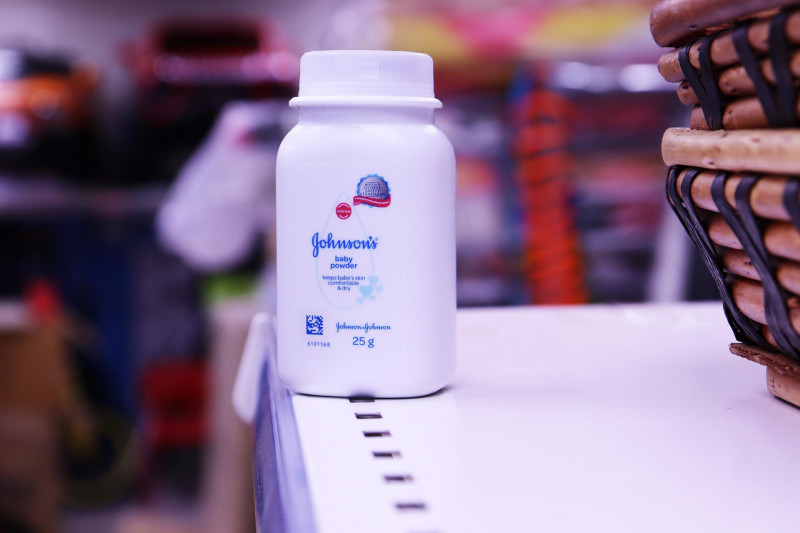
滑石矿物:特性、含义、价值等
 滑石是一种天然粘土矿物,以其世界上最柔软的物质和粉末状的滑石粉而闻名。虽然滑石与其他宝石密切相关,但它通常不被认为是宝石。
滑石是一种天然粘土矿物,以其世界上最柔软的物质和粉末状的滑石粉而闻名。虽然滑石与其他宝石密切相关,但它通常不被认为是宝石。
为什么滑石不被认为是宝石?它太软了,不适合做珠宝。不过,某些富含滑石的石头,比如皂石,却可以用来做装饰品!
此外,滑石粉是许多产品的重要成分,具有重要的工业用途。
今天,您将获得有关滑石粉的用途、历史、治疗特性、品种和价格的 411 信息!
 图片来源:Rob Lavinsky,iRocks.com – CC-BY-SA-3.0
图片来源:Rob Lavinsky,iRocks.com – CC-BY-SA-3.0
关于滑石
滑石,有时也被称为“角质层”,可以形成晶体或块状石头,但晶体非常罕见。最纯净的滑石颜色为白色至无色,带有珍珠光泽。然而,如果含有氧化铁或氧化铝等内含物,则可能会呈现出其他颜色,例如棕色、灰色、黄色、粉色等等。
当人们说“滑石粉”时,他们可能指的是以下四种含义之一:
滑石矿物
滑石的岩石种类(我们稍后会介绍)
工业级滑石粉
化妆品滑石粉
说起来,滑石粉有什么用途呢?
滑石粉的用途
滑石粉的成分涵盖各行各业。滑石粉、滑石粉、硅酸镁、化妆品滑石粉或滑石粉等名称都指滑石粉。通常,滑石粉被碾碎并干燥成柔软的白色滑石粉,可以单独使用或与其他成分混合使用。
其一系列应用源自其独特的属性:
吸收并减少摩擦:保持皮肤干燥,无皮疹;防止磨碎或粉状成分形成肿块
油性质地:润滑,使化妆品光滑如丝
增稠剂:添加到蛋糕、油漆和陶瓷中
耐电和耐热:用于科学实验室柜台、橡胶和配电盘
从矿物方面来看,滑石的特点是什么?
滑石粉规格和特性
滑石的化学式是Mg3Si4O10(OH)2,即水合硅酸镁。常见的杂质包括氟、铁和铝。
滑石粉的滑溜质地源于其结构:薄而堆叠的薄片没有很好地粘合在一起,因此很容易滑落。
在最初的莫氏矿物硬度表中,滑石硬度为标准1级,即抗刮擦性最差。
韧性和解理等因素也会影响其耐久性。遗憾的是,滑石的解理非常完美(是最脆弱的类型),因此也容易破碎。
以下是滑石的所有矿物特性:
颜色:通常为绿色、白色或灰色;有时为棕色、黄色、粉色、蓝色、黑色或无色
晶体结构:单斜或三斜
光泽:珍珠光泽、油腻光泽或暗淡光泽
透明度:半透明(晶体)或不透明(块体)
折射率:1.54-1.59
密度:2.55-2.83
乳沟:完美 [001]
断口:不平整、平坦、纤维状或云母状
条痕:白色
发光:皂石品种中有时会出现荧光;在短波紫外线下呈现粉红色、黄色或绿色,在长波紫外线下呈现浅粉红色、绿黄色或黄色
多色性:有时出现在深色宝石中;较弱;无色至略带棕色

滑石粉的种类
滑石的种类与许多半宝石不同。滑石可能只有一个或两个品种:皂石和滑石,这取决于你问的是谁。
皂石是一种致密、富含镁的变质岩,主要由滑石块以及其他矿物压实而成。它具有叶状结构(薄片状堆积)。有人称之为“皂石”或“皂石”。
然而,矿工和工艺品卖家经常用“皂石”来泛指那些常用于雕塑的质地柔软、质地滑腻的岩石。实际上,他们指的很多石头是蛇纹石或雪花石膏。
滑石:皂石的同义词还是变种?
有些人使用“滑石”作为皂石的同义词,但其他人则将两者区分开来。
后者认为滑石是一种无叶状且几乎完全由滑石组成的皂石。
皂石和滑石(如果分开来看)的硬度都比滑石略高,在1到2.5之间。所以……还是挺软的!
滑石(皂石)价值特性
滑石本身不出售珠宝或装饰品,但皂石却可以!下面,我们将重点介绍影响皂石价值的因素。
颜色
皂石的颜色通常因来源而异,包括白色、灰色、绿色、棕色和红色。皂石可能含有白色、蓝色或绿色的元素。许多皂石呈灰色至灰绿色。
切
皂石几乎总是经过雕刻或塑形,还有一些罕见的凸圆形宝石。
艺术皂石包括小雕像和雕塑。一些建筑皂石可用于制作炊具、吧台和水槽。
尺寸
皂石原石通常体积巨大,适合雕刻重达数磅的物品。尺寸越大的雕刻品价格就越高。
治疗
当加热到 1,830-2,190 °F(1,000-1,200 °C)时,皂石会转变成两种新的石头:方石英和顽辉石。随后,硬度增加到 5.5-6.5。
您知道它可以变成什么,但是滑石晶体能为您做什么呢?

滑石粉的愈合特性
滑石可能不是宝石,但它是一种具有治疗功效的石头!
无色至白色的滑石,如同所有白色宝石一样,能够唤醒更高的灵性意识。毫无疑问,这些水晶是灵性中心——顶轮——的完美脉轮石!
绿色滑石与其他 绿色宝石一样,具有滋养、接地和减轻压力的功效。
让我们仔细看看身体和情感的治愈能力。
身体康复
据说滑石粉可以帮助你养成良好的睡眠习惯,尤其是缓解焦虑引起的失眠。它们还能改善肾脏和肝脏的功能。
情绪疗愈
从情感上来说,滑石粉具有舒缓和安定的功效。水晶治疗师喜欢它带来宁静和提升正念。许多人建议用滑石粉进行冥想,以减轻压力或改善睡眠。
就像水晶治疗本身一样,滑石粉的历史可以追溯到几个世纪以前!
滑石粉的含义和历史
“滑石”一词源于阿拉伯语“talq”和波斯语“ tālk ”。由于滑石与云母矿物相似,其翻译有“纯滑石”和“云母”之分。
古人把许多矿物称为滑石,包括透石膏。中世纪拉丁语“滑石”曾指代许多不同的闪亮矿物。
虽然证据稀少,但据说乔治乌斯·阿格里科拉 (Georgius Agricola) 于 1546 年正式命名了滑石。然而,正如您可能已经猜到的那样,滑石的历史更为悠久,尤其是它的皂石品种。

古代滑石和皂石的历史
滑石或皂石的首次发现时间尚不清楚,但可以追溯到几千年前。
一些最早的考古证据是来自芬兰的麋鹿头皂石雕刻,名为“Elk's Head of Huittinen”,可追溯到大约公元前 7,000 年。
石器时代,斯堪的纳维亚人开始使用皂石进行雕刻。他们率先意识到皂石的吸热和延缓散热的特性。这一特性在金属铸造模具(以及烹饪工具和壁炉隔热材料)中非常有用,这使得斯堪的纳维亚半岛在公元前1750年左右进入了青铜时代。
东海岸的美洲原住民可能在阿巴拉契亚山脉发现了皂石。他们雕刻了各种可追溯到3000至5000年前的物品,包括皂石烟斗、装饰品和碗。
甚至更早的证据表明,大约8000年前,西海岸的美洲原住民就曾划着独木舟,行进60英里到圣克莱门特岛寻找皂石。他们雕刻了皂石碗和人物雕像。

现代滑石粉的历史与争议
如今,如果你问“滑石粉有什么功效?”,你很可能会听到一些负面联想。可悲的是,这些联想在很多情况下都是有道理的。
1886年,罗伯特·伍德·约翰逊和他的兄弟创立了强生公司™(J&J)。不久之后,在1894年,强生公司生产出了第一款滑石粉,并将其作为婴儿爽身粉进行销售,并以“安全第一”作为公司口号。
但强生公司几十年前就发现,他们的滑石粉产品并不安全。研究人员告诉他们,这些产品含有石棉,存在卵巢癌风险。
强生公司没有添加建议的警告标签,而是开始销售另一种爽身粉产品(Shower to Shower),并且多年来一直隐瞒诉讼。
2018 年路透社的一篇热门文章提供了早在 1971 年就对强生婴儿爽身粉进行石棉检测呈阳性的证据,并证明该公司知道存在石棉。
过去几年,卵巢癌或间皮瘤患者对强生公司提起的数百万美元诉讼终于取得了成效。2020年,强生公司正式将其滑石粉婴儿爽身粉从美国和加拿大市场下架。
话虽如此,矿物滑石粉安全吗?如果它不含石棉,那就是安全的。需要进行测试才能确定,所以一定要做好调查,并查看提供此类信息的机构的资金来源。
滑石粉里为什么会含有石棉呢?这和它的形成过程有关。

滑石的形成和来源
滑石和石棉通常形成于相邻区域,因此含石棉矿床中的滑石经常受到污染。这些矿床通常还含有其他致癌矿物,例如透闪石。然而,并非所有滑石矿床都含有石棉。
从形成的角度看,滑石存在于哪种岩石中?矿工们根据滑石矿床内部形成的岩石类型对其进行分类,目前分为三类:
碳酸镁:富含二氧化硅的白云石和菱镁矿;占世界滑石产量的 50% 以上
蛇纹石:富含蛇纹石的变质岩,滑石取代了部分蛇纹石矿物;占滑石的 20% 左右
铝硅酸盐:风化后产生粘土矿物的岩石;占滑石的 10% 左右
滑石的形成方式有两种:热液蚀变或热变质。感到困惑?别担心,我们会逐一讲解!
热液蚀变过程始于硅含量低但镁含量高的岩石。首先,辉石或橄榄石等矿物发生水合,变成蛇纹石。然后,二氧化碳将蛇纹石转化为菱镁矿和滑石。
热变质过程是低级的,意味着低压到中压和温度会使岩石发生改变,但不会剧烈改变。
热变质作用发生在碳酸镁岩中,例如白云石和菱镁矿。首先,水带走了岩石中的二氧化硅,但镁仍留在原地。碳酸镁与含二氧化硅的水发生反应,形成了富含滑石的新岩石。
考虑到这一点,滑石在哪里被发现?
采矿地点
目前,全球滑石生产大国依次为中国、美国、日本。美国以蒙大拿州、德克萨斯州和佛蒙特州为主要滑石生产州。
其他主要供应商包括:
澳大利亚
巴西
加拿大
中部非洲
芬兰
法国
印度
俄罗斯
韩国
皂石分布范围较小。在北半球很少见到它,因为季节性冰冻或冰川会破坏沉积物。巴西是皂石的最佳产地,因为它缺乏这些条件。
那么,滑石片岩值多少钱?皂石又值多少钱呢?
 图片来源:Rob Lavinsky,iRocks.com – CC-BY-SA-3.0
图片来源:Rob Lavinsky,iRocks.com – CC-BY-SA-3.0
滑石粉的价格和价值
滑石价格极其实惠。几乎都是以原石出售,价格按重量在 11 至 16 美元之间——1-2 磅的滑石约 16 美元,26-100 磅的滑石约 11 美元。
皂石的价格通常比较实惠,但更取决于其品质,尤其是历史价值。例如,一件真正的、历史悠久的因纽特人雕刻品,售价可能在4000至6000美元之间。
现代皂石雕刻的价格要低得多。小型雕像通常每个售价4至6美元,而中型雕像(8至15英寸)通常售价20至50美元。粗糙的皂石价格最便宜,通常每磅约2美元。
滑石粉的保养和维护
滑石极其脆弱, 保养这类晶体需要格外小心。即使用指甲,也很容易刮伤它。
要清洁滑石,请用温水仔细冲洗。蒸馏水是最佳选择,因为自来水中的矿物颗粒可能会刮伤滑石。
将滑石粉放入真空密封或密闭容器中,并存放在干燥、阴凉、远离常去区域的地方。
想要比丝绸更柔软的石头吗?
无论你拥有过多少矿物质,都无法比得上滑石的触感。它柔软滑溜的质地完美地体现了其舒缓、镇静的特性。无论你用它来装饰皂石台面,还是用它来雕刻装饰物,你都能沉醉于它令人放松的韵律——并且知道你拥有的是一段历史!
想探索滑石和其他矿物吗?快来选购我们丰富的系列产品吧!
搜索Gemstone Encyclopedia
最新的文章
棕榈象牙雕刻,又称植物象牙,是象牙的天然替代品,取自南美洲棕榈树(Phytelephas palm)的果实,并以符合伦理的方式采集。本指南将带您全面了解棕榈象牙!
15th Jan 2026
彩虹格纹日光石是一种长石,由于内部含有各种包裹体,呈现出三种绚丽的光学效应。它绚丽多彩的光泽和格纹图案使其成为收藏家梦寐以求的珍宝!
12th Jan 2026
文章分类
How To's is where you will find helpful articles from gem Rock Auctions on how to cut gemstones, select gemstones and buy gemstones.
9文章数
